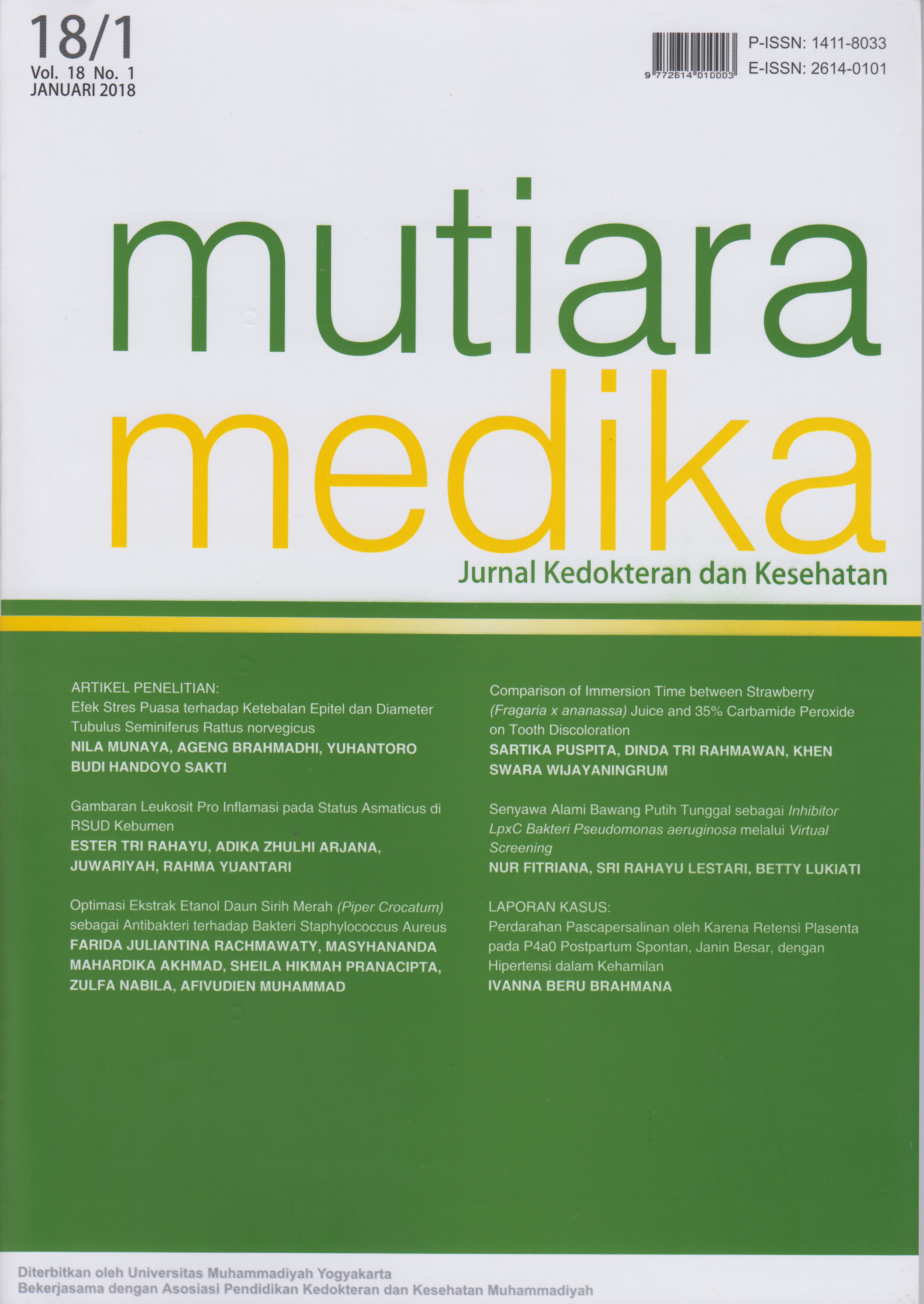Comparison of Immersion Time between Strawberry (Fragaria x ananassa) Juice and 35% Carbamide Peroxide on Tooth Discoloration
DOI:
https://doi.org/10.18196/mm.180110Keywords:
Teeth Whitening, Strawberry Fruit (Fragaria x ananassa), 35% Carbamide Peroxide, Shade Guide, SpectrophotometerAbstract
Tooth color is one of the aesthetic problems in society. This condition is influenced by extrinsic and intrinsic factors. 35% Carbamide peroxide is an ingredient approved by the American Dental Association (ADA) as safe and effective tooth whitening. Strawberry (Fragaria x ananassa) is a natural substance containing ellagic acid that can be used for tooth whitening. The purpose of this study is to determine the tooth discoloration after the immersion of F. x ananassa juice 100% and 35% carbamide peroxide. The method of this research was a pure laboratory experiment. The sample used was 24 premolar postpartum teeth which had been discolored using tea. The specimens were divided into 2 groups, the first group was immersed with F. x ananassa juice 100% and the second group was immersed with 35% carbamide peroxide, respectively for 30, 60, and 90 minutes. The color of the immersed teeth was then measured by a spectrophotometer and a shade guide to determine the color change before and after the treatment. Data were analyzed using Two Way ANOVA and Kruskal-Wallis test. The results of this study indicated that the immersion of F. x ananassa juice 100% was able to make the teeth become brighter, with the same level of brightness using 35% carbamide peroxide. The conclusion of this research was F. x ananassa juice can be used as an alternative material for tooth whitening.
References
Istianah I, Ekoningtyas EA, Benyamin B. Perbedaan Pengaruh Hidrogen Peroksida 35% dan Karbamid Peroksida 35% terhadap Microleakage pada Resin Komposit Nanohybrid. Odonto Dental Journal, 2015; 2 (1): 20-24.
Tin-oo MM, Saddki N, Hassan N. Factors Influencing Patient Satisfaction with Dental Appearance and Treatments They Desire to Improve Aesthetics. BMC Oral Health, 2011; 11 (1): 6.
Watts A, Addy M. Tooth Discoloritation and Staining: a Review of the Literature. Br Dent J, 2001; 190 (6): 309–316.
Meizarini A. Bahan Pemutih Gigi dengan Sertifikat ADA/ISO (Tooth Bleaching Material with ADA/ISO Certificate). Majalah Kedokteran Gigi, 2005; 38 (2): 73-76.
Nurbaetty R, Merry CRD, Lestari S. Potensi Jeruk Nipis (Citrus aurantifolia) dalam Memutihkan Email Gigi yang Mengalami Diskolorasi. Insisiva Dental Journal, 2014; 3 (1): 78-83.
Carey CM. Tooth Whitening: What We Now Know. J Evid Based Dent Pract, 2014; 14 (70-72): 1-12.
Suprastiwi E. Penggunaan Karbamid Peroksida sebagai Bahan Pemutih Gigi. Indonesian Journal of Dentistry, 2005; 12 (3): 139-145.
Freedman G. Contamporary Esthetics Dentistry. United States: Mosby. 2011. p. 399.
Sugianti N. Efek Ekstrak Rosella (Hibiscus sabdarifa) sebagai Bahan Alternative Pemutih Gigi Alami pada Kasus Pewarnaan Eksternal. Insisiva Dental Journal, 2012; 1 (2): 5-9.
Hartanto A, Rianti D, Meizarini A. Aplikasi Pasta Stroberi sebagai Material Bleaching terhadap Perubahan Warna dan Kekerasan Permukaan Enamel. JMKG, 2012; 1 (1): 7-14.
Nuzulya P, Effendi C, Nugraeni Y. Pengaruh Pemberian Jus Apel terhadap Pemutihan Gigi Setelah Direndam Larutan Kopi Secara in Vitro. Insisiva Dental Journal, 2012; 1 (2): 17-19.
Syahland ME, Setyawati A. Efektifitas Penggunaan Buah Anggur (Vitis vinifera L.) sebagai Bahan untuk Pemutih Gigi (Bleaching) Berdasarkan Perbedaan Konsentrasi. Insisiva Dental Journal, 2013; 2 (1): 50-56.
Downloads
Published
Issue
Section
License
Copyright
Authors retain copyright and grant Mutiara Medika: Jurnal Kedokteran dan Kesehatan (MMJKK) the right of first publication with the work simultaneously licensed under an Attribution 4.0 International (CC BY 4.0) that allows others to remix, adapt and build upon the work with an acknowledgment of the work's authorship and of the initial publication in Mutiara Medika: Jurnal Kedokteran dan Kesehatan (MMJKK).
Authors are permitted to copy and redistribute the journal's published version of the work (e.g., post it to an institutional repository or publish it in a book), with an acknowledgment of its initial publication in Mutiara Medika: Jurnal Kedokteran dan Kesehatan (MMJKK).
License
Articles published in the Mutiara Medika: Jurnal Kedokteran dan Kesehatan (MMJKK) are licensed under an Attribution 4.0 International (CC BY 4.0) license. You are free to:
- Share — copy and redistribute the material in any medium or format.
- Adapt — remix, transform, and build upon the material for any purpose, even commercially.
This license is acceptable for Free Cultural Works. The licensor cannot revoke these freedoms as long as you follow the license terms. Under the following terms:
Attribution — You must give appropriate credit, provide a link to the license, and indicate if changes were made. You may do so in any reasonable manner, but not in any way that suggests the licensor endorses you or your use.
- No additional restrictions — You may not apply legal terms or technological measures that legally restrict others from doing anything the license permits.






